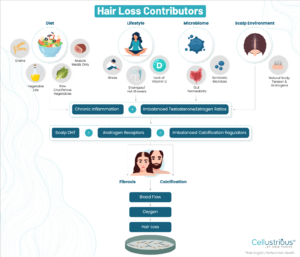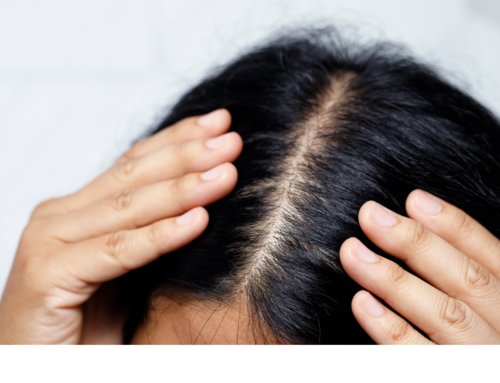Microneedling for hair regrowth has been the subject of significant research over the past few years, producing some very promising results. This treatment is the cornerstone of Cellustrious®’s comprehensive approach to hair loss as we continue to research the dilemma of hair loss.
Microneedling was originally designed to revitalize the skin and diminish the appearance of scars and abnormal pigmentation. The process involves a device with an electrically oscillating mechanism that creates superficial punctures in the skin.
In skin treatments, enhancement is attributed to the body’s inherent healing reaction to trauma, even minor, superficial injuries. The numerous shallow perforations also facilitate the penetration of applied products.
For hair restoration, we focus on the role of trauma in:
- Reduce fibrosis and scarring
- Increase localized blood flow
- Enhance penetration of bio-signals
Dermatologic studies confirmed micro-wounding’s benefits on hair regrowth with AGA, using 1.5 mm on humans, and the positive impact of the effect that microneedling has cannot be discounted.
As evidenced by the wounding’s regrowth of hair and improvement in scars, if we “acutely” injure areas already ridden with calcification and fibrosis, the healing process seems to resolve much of the calcification and fibrosis.
The Role of Inflammation in Healing
When we injure a tissue, our bodies generate an acute inflammatory response that allows the body to repair the injury. If an injury is too severe – like a deep cut – our bodies repair the wound imperfectly, resulting in scar tissue.
When an injury is minor – like the acute inflammation generated from microneedling – our bodies can control the healing process and achieve perfect wound healing.
Acute inflammation is different from chronic inflammation. Acute inflammation is temporary and often caused by injury.
Chronic inflammation – the kind that results in hair loss – is prolonged and often results in calcification and fibrosis.
Inflammation in Balding Scalps
Inflammation in balding scalps may show us the connection between oxygen loss and its role in hair loss.
In a study comparing balding and non-balding scalps, researchers discovered that balding scalps generate finer, less pigmented hairs with significantly reduced vascularization.
Upon providing balding scalp cultures with supplemental blood supply, the growth rate of these cultures increased by approximately 80%.
In another study, biopsies conducted on balding scalps unveiled a troubling presence: vascular thrombosis, an occlusion within blood vessels that hampers the vital flow of blood and nutrients crucial for nourishing hair follicles.
In the final stages of pattern baldness, the tissue surrounding the follicle gradually lost its capillaries until the skin appeared to be deprived of blood vessels. Similarly, reduced scalp oxygenation was noted (Goldman et al. in 1996). There was vascular insufficiency in regions of the scalp that lose hair during male pattern baldness.
In 2010, Freund and Schwartz demonstrated that injections of botulinum toxin (botox) resulted in increased oxygen delivery to the frontal areas of the scalp, resulting in reduced hair loss and new growth among men with pattern baldness.
All of these studies point to the theory that inflammation may play a much larger role in hair loss and balding scalps than what was once thought.
Chronic Inflammation
Persistent inflammation and hormonal fluctuations trigger a gradual transformation in our blood vessels and soft tissues, leading to calcification and fibrosis.
This process manifests uniquely in individuals; for some, it leads to hair thinning, seen as scalp calcification, while others may experience its effects in various bodily regions, such as heart disease.
There are some people fortunate enough to evade its impact entirely, exhibiting no outward signs of calcification or fibrosis. This diversity in expression underscores the complex interplay between genetic predispositions, environmental factors, and physiological responses.
As a result, the manifestation of calcification and fibrosis serves as a multifaceted reflection of an individual’s unique biological makeup and life experiences.
Addressing Calcification and Fibrosis
Reversing scalp calcification and fibrosis in the scalp has proven to be effective through the application of energetic or mechanical stimulation through modulated acute injury, or both – is the best scientifically validated method.
The most promising, effective stimulation technique to date is through microneedling.
Microneedling Evidence on Hair Regrowth
Acute wounds trigger the downregulation of calcification inducers, such as transforming growth factors, while simultaneously upregulating calcification inhibitors that facilitate scarless healing.
This process, known as “acute inflammation generation,” orchestrates a delicate balance among calcification regulators. By modulating the expression of these factors, the body navigates a pathway toward effective tissue repair while mitigating the risk of excessive calcification and fibrosis.
The dynamic interplay between the downregulation of promoters and the upregulation of inhibitors within the wound microenvironment fosters an environment conducive to optimal healing outcomes.
This offers a promising avenue for interventions aimed at reversing scalp calcification and fibrosis. Through targeted approaches that harness the power of acute injury and its associated inflammatory responses, researchers explore avenues to restore scalp health and combat the adverse effects of calcification and fibrosis on hair follicle function and overall scalp integrity.
Pattern hair loss requires a trifecta of factors: elevated androgens, heightened androgen receptors, and disrupted calcification regulators.
Acute wounding tackles the third variable by recalibrating calcification regulators. In this process, it not only addresses ongoing calcification and fibrosis but also initiates a reversal.
By modulating the interplay of these factors, acute wounding presents a promising strategy for mitigating the progression of pattern hair loss. Its capacity to restore equilibrium among calcification regulators underscores its potential as a therapeutic intervention.
Through targeted approaches that leverage the innate healing mechanisms of the body, researchers explore avenues to counteract the deleterious effects of calcification and fibrosis on scalp health.
As acute wounding emerges as a focal point in hair loss management, its role in addressing the underlying mechanisms of pattern hair loss offers hope for those grappling with this prevalent condition.
Acute wounding serves as a catalyst for angiogenesis, the intricate process of generating new blood vessels and capillary networks that nourish hair follicles with oxygen and essential nutrients.
In contrast, calcification and fibrosis impede blood flow and oxygen delivery to the follicles, precipitating gradual thinning over time. By instigating the formation of fresh blood vessels around thinning follicles, a resurgence of blood flow and oxygen ensues. This revitalization offers a potential avenue for thickening existing hair and stimulating regrowth.
Through the re-establishment of robust blood circulation and oxygenation, the delicate ecosystem of the scalp undergoes rejuvenation.
As a result, the dormant follicles, once deprived of sustenance, awaken to the influx of revitalizing elements, fostering an environment conducive to hair thickening and potential regenerative processes.
As acute wounding emerges as a pivotal player in this intricate dance of scalp restoration, its ability to spark angiogenesis presents a promising strategy for combatting the insidious effects of calcification and fibrosis. In harnessing the power of angiogenesis, we unlock a pathway toward rejuvenation and revitalization in the realm of hair health.
This chart shows the cascade that chronic inflammation, fibrosis, and calcification can create in the body, leading to hair loss.
If you suspect that inflammation and/or calcification is impacting your hair, reach out to Cellustrious® at 941-909-7701, or schedule a FREE 15 minute consultation with us. Our team is dedicated to providing assistance and support to address your concerns and improve your health.
We understand the importance of proactive intervention and are committed to guiding you through the process of identifying and addressing any potential issues affecting your hair and overall wellness.
Your health and comfort are our priority, and we are here to offer guidance, support, and solutions tailored to your unique needs. Don’t let uncertainty or discomfort hold you back—take the first step towards reclaiming your health and vitality by contacting us today.






